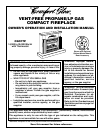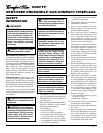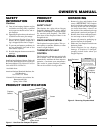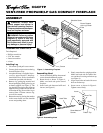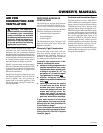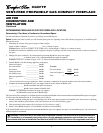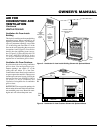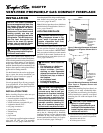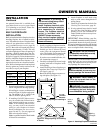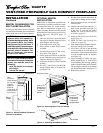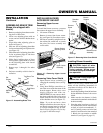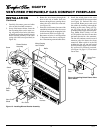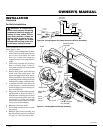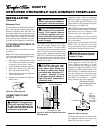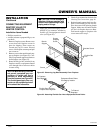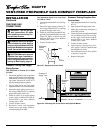
7
107036
OWNER’S MANUAL
Figure 6 - Ventilation Air from Outdoors Shown with Optional Mantel
Outlet
Air
Ventilated
Attic
Outlet
Air
Inlet
Air
Inlet Air
Ventilated
Crawl Space
To
Crawl
Space
To Attic
AIR FOR
COMBUSTION AND
VENTILATION
Continued
Figure 5 - Ventilation Air from Inside Building Shown with Optional Mantel
VENTILATION AIR
Ventilation Air From Inside
Building
This fresh air would come from an adjoining
unconfined space. When ventilating to an
adjoining unconfined space, you must pro-
vide two permanent openings: one within
12" of the ceiling and one within 12" of the
floor on the wall connecting the two spaces
(see options 1 and 2, Figure 5). You can also
remove door into adjoining room (see op-
tion 3, Figure 5). Follow the National Fuel
Gas Code, ANSI Z223.1/NFPA 54, Section
5.3, Air for Combustion and Ventilation for
required size of ventilation grills or ducts.
Ventilation Air From Outdoors
Provide extra fresh air by using ventilation
grills or ducts. You must provide two per-
manent openings: one within 12" of the
ceiling and one within 12" of the floor.
Connect these items directly to the outdoors
or spaces open to the outdoors. These spaces
include attics and crawl spaces. Follow the
National Fuel Gas Code, ANSI Z223.1/NFPA
54, Section 5.3, Air for Combustion and
Ventilation for required size of ventilation
grills or ducts.
IMPORTANT:
Do not provide openings for
inlet or outlet air into attic if attic has a thermo-
stat-controlled power vent. Heated air enter-
ing the attic will activate the power vent.
Or
Remove
Door into
Adjoining
Room,
Option 3
Ventilation Grills
Into Adjoining Room,
Option 2
12"
12"
Ventilation
Grills
into Adjoining
Room,
Option 1



